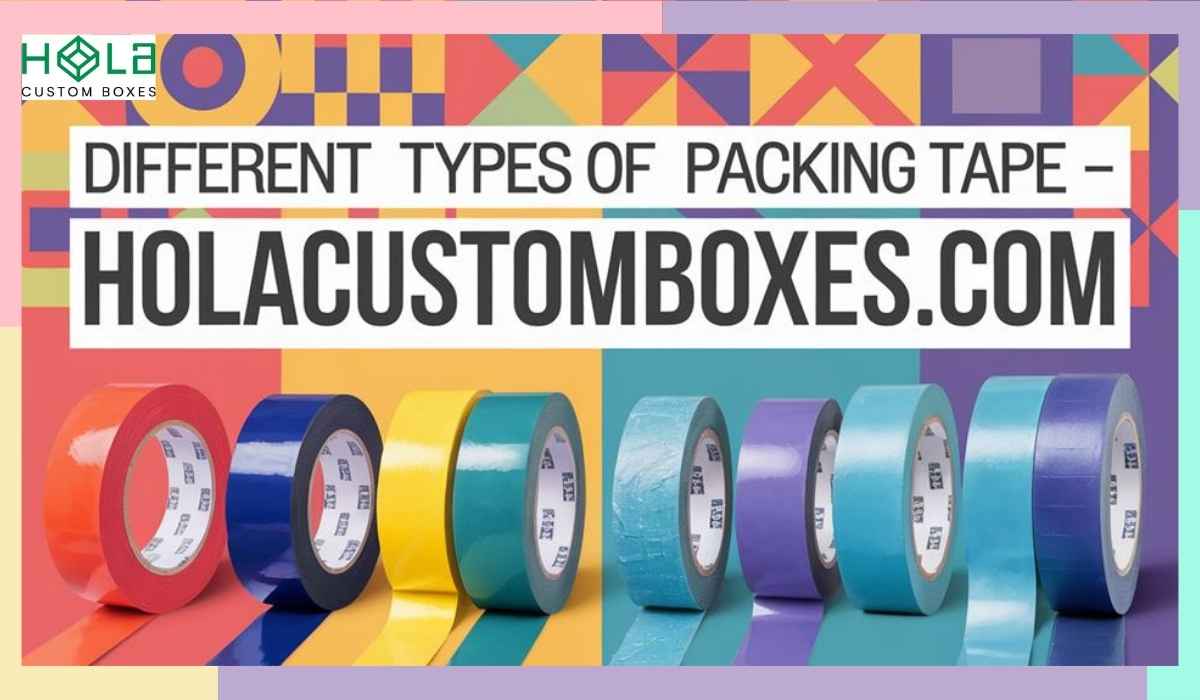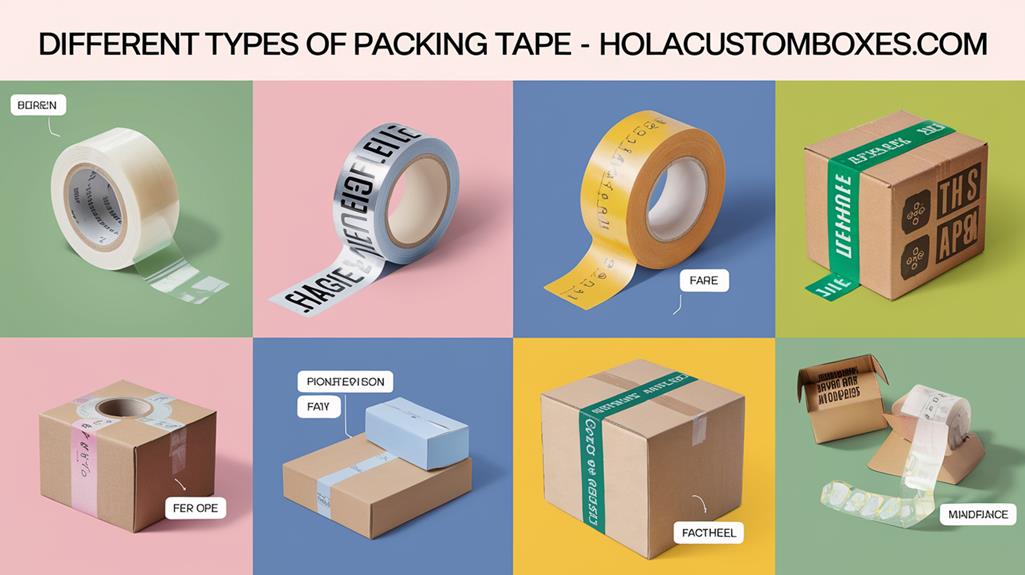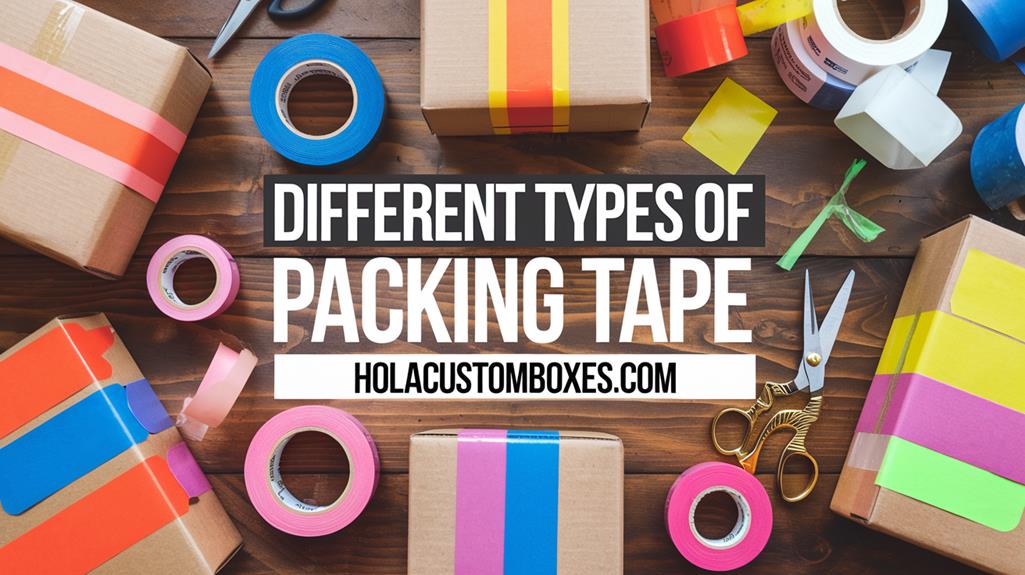Get To Know Different Types of Packing Tape
2025-08-04 12:45:15
Packing tape comes in various types tailored for specific applications. Acrylic packing tape offers instant bonding and UV resistance, making it suitable for outdoor use. Hot melt tape is preferred for heavy-duty tasks due to its strong adhesive. Gummed paper tape provides tamper evidence, while filament tape enhances tensile strength for bundling. Cold-temperature and PVC tapes maintain adhesion in extreme conditions. Water-activated tape is ideal for fragile items, whereas masking and duct tape are versatile for temporary sealing. Selecting the appropriate type hinges on weight, environmental factors, and adhesive properties, leading to informed choices for effective packing solutions. More options await your exploration.
Main Points
Acrylic Packing Tape offers instant bonding and UV resistance, making it suitable for outdoor use in temperatures from 32°F to 150°F.
Hot Melt Packing Tape: This tape is ideal for heavy-duty applications over 60 lbs. Its thicker adhesive allows for rapid bonding in high-speed packaging.
Gummed Paper Tape: Water-activated and tamper-evident, reinforced with fiberglass for extreme conditions, perfect for fragile items.
Filament Tape: Enhanced with fiberglass filaments, providing high tensile strength, making it excellent for bundling and securing heavy loads.
Cold-Temperature Tape: Maintains adhesive properties in low-temperature environments, ensuring reliable sealing in cold conditions.
Understanding the Role of Packing Tape in Shipping
Packing tape is a crucial component in the logistics and shipping industries, providing a dependable solution for sealing and securing boxes during transit. This pressure-sensitive adhesive tape typically ranges in width from 2 to 3 inches, allowing it to accommodate a variety of box sizes. Made from durable materials like polypropylene and polyester, packing tape comes in multiple types—including acrylic, hot melt, and reinforced options—each designed to meet specific packaging needs and environmental conditions.
Choosing the Right Tape for Strength and Security
The effectiveness of packing tape largely depends on its thickness and adhesive strength. For boxes weighing over 25 lbs, a tape thickness of 2 to 2.4 mil is generally recommended, while heavier packages exceeding 60 kg require at least 3 mil thick tape. Specialty options like water-activated tape offer tamper-evident features, making them ideal for high-value or sensitive shipments. Selecting the appropriate packing tape not only enhances package durability but also helps reduce damage during transit, contributing to improved customer satisfaction and operational efficiency.
Types of Packing Tape

Various types of packing tape cater to specific sealing needs and conditions, ensuring ideal performance in diverse applications.
Acrylic packing tape is well-regarded for its instant bonding capabilities and operates effectively within a temperature range of 32 to 150°F. This makes it suitable for general sealing purposes while providing clarity when viewing content.
Hot melt packing tape, characterized by its thicker adhesive, excels in heavy-duty applications, making it ideal for sealing boxes weighing over 60 lbs.
For those requiring a tamper-evident seal, gummed paper tape is activated with water and reinforced with fiberglass, ensuring tear resistance even under extreme temperatures.
Enhanced with fiberglass filaments, filament tape offers high tensile strength, making it an excellent choice for securely bundling and reinforcing packages during shipping.
Finally, cold-temperature tape is designed to maintain adhesive properties in low-temperature environments, ensuring reliable performance in challenging conditions.
Each type of tape serves a distinct purpose, providing practical solutions for sealing boxes and meeting various packaging requirements.
Adhesive Variations In Packing Tapes
Different types of packing tape utilize specific adhesive formulations to enhance their performance across various applications. Among the most common adhesives are acrylic, rubber, and hot melt options, each offering distinct advantages.
Acrylic packaging tape features a UV-resistant formulation, making it suitable for outdoor use and capable of withstanding temperatures from 32°F to 150°F. This characteristic guarantees durability and longevity when exposed to varying environmental conditions.
The rubber adhesive is recognized for its initial solid tack and quick bonding properties. These properties enable a reliable seal for packaging tasks that require immediate adherence, making it ideal for fast-paced environments.
Hot melt adhesive is another prevalent choice, known for its rapid bonding capabilities. It is particularly advantageous in high-speed packaging due to its superior adhesion performance, assuring that packages are secured efficiently.
Additionally, while not as commonly discussed, silicone adhesives provide high-temperature resistance for specialized applications subject to heat exposure. Water-based adhesives offer an environmentally friendly alternative to biodegradable solutions.
Selecting an appropriate adhesive notably influences the effectiveness and suitability of packing tape for specific tasks.
Application Techniques Of Packing Tape

Effective application techniques are vital for optimizing the use of packing tape in various packaging scenarios. The choice of tape dispenser dramatically impacts the efficiency of packing operations. Hand dispensers are particularly suited for small to medium tasks, offering versatility and ease of application for different tape types.
Conversely, automatic dispensers cater to large-scale operations, enhancing efficiency by minimizing the time spent on manual tape application.
Another practical approach is to utilize tape guns. These user-friendly tools enable quick and precise application of packing tape, reducing waste and improving sealing effectiveness. In specific applications, such as food packaging, heat sealing may guarantee strong bonds between tape and packaging materials, enhancing durability and integrity.
Moreover, proper loading techniques for tape dispensers are critical. Ensure that dispensers are loaded correctly to prevent jams and ensure smooth operation, which is vital for maintaining packing speed and minimizing delays.
Choosing the Right Tape For Packaging
Selecting the appropriate packing tape is essential for guaranteeing the secure and reliable sealing of packages. When choosing the suitable tape, consider the package's weight. For heavy items exceeding 25 lbs, a tape thickness of at least 2-2.4 mil is recommended, while packages over 60 kg necessitate a thickness of three mil or more to guarantee effective sealing.
The stability of the contents also plays a critical role in tape selection. Unstable items require more vital tapes to maintain a secure seal, whereas valuable items benefit from high-adhesion tapes to prevent tampering or damage during transit.
Clear packing tape is typically sufficient for general applications; however, heavy-duty options with aggressive adhesives should be employed for long-term storage or shipping of recycled boxes.
Another important factor is the adhesive type; hot melt tape provides superior initial tack for quick sealing, while acrylic tape offers UV resistance, making it suitable for outdoor use.
Furthermore, consider environmental conditions; cold-temperature tapes are designed to retain adhesion in extreme cold, while gummed paper tape offers a tamper-evident seal. By carefully evaluating these factors, one can guarantee effective packing tape selection.
Environmental Considerations For Packing Tape
As sustainability becomes a priority in packaging solutions, environmental considerations in selecting packing tape have gained prominence. The packaging industry is increasingly adopting recyclable tapes made from materials such as paper and biodegradable plastics, which contribute notably to reducing packaging waste. These options enhance the recyclability of packaging materials and align with eco-conscious consumer preferences.
Moreover, developing packing tapes utilizing water-based adhesives presents a less toxic and more environmentally friendly alternative to traditional solvent-based tapes. Such innovations are integral to the shift towards sustainable sourcing, where manufacturers prioritize responsibly sourced materials to minimize their environmental impact.
Lifecycle assessments are now standard practice in evaluating the environmental footprint of packaging tapes, considering factors from production to disposal. This thorough approach aids in selecting tapes that meet sustainability criteria.
Furthermore, advancements in tape technology aim to reduce plastic use, with alternatives like gummed paper tape providing robust sealing capabilities without reliance on synthetic materials. These developments underscore the industry's commitment to environmentally responsible practices, making a notable contribution to sustainability efforts in packaging.
Packing Tape Industry Standards
Industry standards are essential in guaranteeing packing tapes' quality, safety, and performance across various applications. The American Society for Testing and Materials (ASTM) standards provide critical guidelines for evaluating packing tapes' performance and establishing criteria for strength, adhesion, and durability.
Adherence to these standards guarantees that manufacturers produce tapes capable of withstanding the rigors of various environments, thereby enhancing user confidence.
In addition to ASTM standards, compliance with Food and Drug Administration (FDA) regulations is paramount for tapes intended for food packaging. These regulations guarantee that tape materials are safe for direct contact with consumables, safeguarding public health.
ISO certifications serve as a robust quality assurance measure throughout the manufacturing process. They promote consistency and reliability, allowing consumers to trust that the products meet internationally recognized quality benchmarks.
Additionally, safety standards are established to protect users during industrial applications, minimizing risks associated with handling and application.
Best Practices for the Use of Packaging Tape
Effective utilization of packing tape is imperative for guaranteeing the integrity of sealed packages. To achieve peak results, consider employing the H tape method, which reinforces sealing your boxes by applying tape along the seams and across the flaps. This technique is particularly beneficial for storage, providing a robust seal that deters pests and debris.
When applying tape, verify that dispensers are loaded correctly to minimize waste and enhance application efficiency. A single tape strip is typically sufficient for moving boxes, whereas the H method is recommended for long-term storage.
Additionally, maintaining an adequate inventory of quality packing tape is critical. To preserve its adhesive properties, store tape in a cool, dry environment (4 to 27°C, 40-50% humidity).
Utilizing packing tape dispensers is also advantageous; they streamline the application process and reduce the time required for sealing your boxes.
| Practice | Description |
|---|---|
| H Tape Method | Applies tape along seams and flaps for strength |
| Proper Dispenser Loading | Reduces waste and improves application efficiency |
| Single Tape Strip | Sufficient for moving boxes |
| Inventory Management | Regularly assess and store in ideal conditions |
| Use of Dispensers | Increases efficiency and minimizes sealing time |
